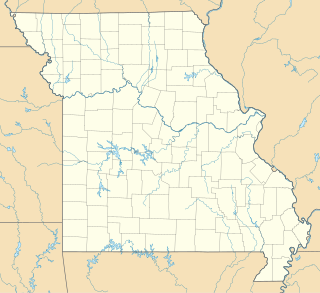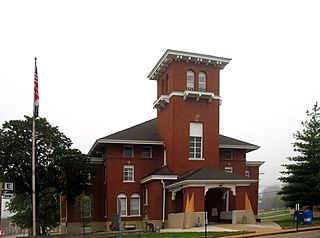
Moselle is an unincorporated community in Franklin County, Missouri, United States. It is located approximately five miles northeast of St. Clair.

Onota was a village in the Upper Peninsula of the U.S. state of Michigan. It was located on the Grand Island Bay of Lake Superior near the present-day community of Christmas about five miles (8 km) west of Munising in Alger County. The site of Onota is within the Bay Furnace Campground and Picnic Area of the Hiawatha National Forest. The remains of Bay Furnace, a blast furnace used for smelting iron, is the only extant remnant of the town. Bay Furnace was listed on the National Register of Historic Places and designated a Michigan State Historic Site in 1971.

Oxford Furnace is a historic blast furnace on Washington Avenue, near the intersection with Belvidere Avenue, in Oxford, Oxford Township, Warren County, New Jersey. The furnace was built starting in 1741 and produced its first pig iron in 1743. The first practical use in the United States of hot blast furnace technology took place here in 1834. The furnace was added to the National Register of Historic Places on July 6, 1977 for its significance in industry during the 19th century. It was later added as a contributing property to the Oxford Industrial Historic District on August 27, 1992.

Lonaconing Furnace, also known as The George's Creek Coal and Iron Company Furnace No. 1, is a historic iron furnace in Lonaconing, Allegany County, Maryland, United States. It is a truncated square pyramid constructed of sandstone, 50 feet (15 m) high, 50 feet square at the base, and 25 feet square at the top. It first produced iron in 1839, then the iron operation was abandoned in the mid-1850s, the Loncaconing Furnace complex included a top house, molding house, engine house, and two hot-air furnaces for heating the blast. None of these ancillary structures remains. It played a significant role in demonstrating that both coke and raw bituminous coal could be used as fuels in the manufacture of iron. It is known as "the first coke furnace, whose operation was successful, erected in this country."
This is a list of the National Register of Historic Places listings in Stewart County, Tennessee.

Monroe Furnace is a national historic district and historic iron furnace located at Barree Township in Huntingdon County, Pennsylvania. It consists of 1 contributing site and 1 contributing structure. They are the remains of the furnace stack, its immediate surroundings, and the visible foundation remains of 14 workers' houses. The furnace stack measures 30 feet square at the base and stands 20 feet tall. The furnace was established in 1846-1847 by General James Irvin. It was in operation until 1863. It is included in the Pennsylvania State University Experimental Forest.

Huntingdon Furnace is a national historic district and historic iron furnace and associated buildings located at Franklin Township in Huntingdon County, Pennsylvania. It consists of seven contributing buildings and one contributing structure. They are the iron furnace, office building, the ironmaster's mansion, log worker's house, a residence, the farm manager's residence, the grist mill and the miller's house. The iron furnace was moved to this site in 1805, from its original site one mile upstream. It measures 30 feet square by 30 feet high. The ironmaster's mansion was built in 1851, and is a 2 1/2-story, "L"-shaped frame dwelling. The grist mill dates to 1808, and is a 3 1/2-story, rubble stone building measuring 50 feet by 45 feet. The furnace was in operation from 1796, until it ceased operations in the 1880s.

Barree Forge and Furnace, now known as Greene Hills Methodist Camp, is a national historic district located at Porter Township in Huntingdon County, Pennsylvania. It consists of two contributing buildings, one contributing site, and one contributing structure associated with a former ironworks. They are the ironmaster's mansion, furnace stack, a barn, and the site of the Barree iron forge built about 1797. The ironmaster's mansion was built in the 1830s, and is a 2 1/2-story brick house painted white. The furnace stack dates to 1864, and is a 30-foot square, coursed limestone structure. It measures between 6 and 15 feet tall. The ironworks closed in the 1880s. The property was acquired in 1963, by the United Methodist Church for use as a church camp.

Paradise Furnace, also known as Mary Anne Furnace, is a national historic district located in Trough Creek State Park at Todd Township in Huntingdon County, Pennsylvania. It consists of two contributing buildings and one contributing structure associated with a former iron furnace. They are the ironmaster's mansion, furnace stack, and a log workers' house. The ironmaster's mansion was built in the 1830s, and is a 2 1/2-story stone house in the Georgian plan. The furnace stack dates to the 1830s, and is a 28-foot square, coursed rubble stone structure. It measures between 15 and 20 feet tall. The ironworks operated from the late-18th century into the 1860s, when economic conditions caused it to be fired. The two-story log house dates to the late-18th century. It was converted for use as the park visitor's center / museum in 1982.

Carrick Furnace is a historic iron furnace located at Metal Township in Franklin County, Pennsylvania. The property includes the limestone furnace stack, a Peter L. Weimer blowing engine (1879), boilers for the steam engine, and the charging ramp, engine house, and cast house foundations. The furnace was built about 1828, and measures 30 feet square at the base and 30 feet high. Furnace operations were suspended in 1837, the property sold in 1843, then leased in 1850 to "Witherow and Walker." The furnace was converted in 1879 to hot blast with the installation of the steam-powered blowing engine. The furnace went out of blast in 1884, and was donated to the Franklin County Historical Society-Kittochtinney in 1935.

Franklin Furnace Historic District is a national historic district located in St. Thomas Township, Franklin County, Pennsylvania. The district includes five contributing buildings, one contributing structure, and one contributing site associated with a 19th-century iron furnace plantation. The buildings are the manager's house / office and four workers' houses. The structure is the furnace stack (1828). It measures 30 feet square at the base and approximately 30 feet tall. The contributing site is the ruins of a barn. The furnace ceased full operation in 1882.

The Beckley Furnace Industrial Monument is a state-owned historic site preserving a 19th-century iron-making blast furnace on the north bank of the Blackberry River in the town of North Canaan, Connecticut. The site became a 12-acre (4.9 ha) state park in 1946; it was added to the National Register of Historic Places in 1978.

Mt. Torry Furnace, also known as Virginia Furnace, is a historic iron furnace located at Sherando, Augusta County, Virginia. It was built in 1804, and is a stone square trapezoid measuring 30 feet at the base and 40 feet tall. The original cold-blast charcoal stack was converted for hot blast in 1853. It shut down in 1855, then was reactivated in 1863 to support the Confederate States Army. The furnace was destroyed in June 1864 during the American Civil War by Brigadier General Alfred N. Duffié, then rebuilt in January 1865. It operated until 1884.

Callie Furnace is a historic iron furnace located near Glen Wilton, Botetourt County, Virginia. It was built as a hot-blast charcoal furnace around 1873-1874, and subsequently enlarged and converted into a coke furnace. In 1883, the stack was raised an additional five feet, and a tuyere was added. Callie Furnace went out of blast in 1884.

The Forest Dale Iron Furnace was a 19th-century iron smelting facility in Brandon, Vermont. Located off Vermont Route 73 east of the village of Forest Dale, it operated between 1810 and 1855, closing due to competition from higher quality and more efficient furnaces. Now reduced to archaeological ruins and the remains of its main furnace stack, it was listed on the National Register of Historic Places in 1974. The site is marked by a historic marker on Vermont 73.

Scotia Iron Furnace Stack is a historic iron furnace stack located near Leasburg, Crawford County, Missouri. It was built about 1870 by the Scotia Iron Works, and is 35 feet wide at the base, and approximately 40 feet high. It is constructed of native limestone blocks. The furnace remained in operation until 1880.

Moselle Iron Furnace Stack is a historic iron furnace stack located near Moselle, Franklin County, Missouri. It was built in 1848-1849 by the Moselle Iron Furnace (1850-1854), and later operated as the Furnace of the Franklin Iron Mining Co. (1855-1859), and Moselle Iron Company (1874-1875). It is 31 feet high and constructed of cut stone blocks. The furnace was closed in early June 1875.
Fertile is an unincorporated community in Washington County, in the U.S. state of Missouri.

Ozark Iron Furnace Stack, also known as the Ozark Iron Works, is a historic iron furnace located near Newburg, Phelps County, Missouri. It was built in 1873, and is a pyramidal shaped furnace stack constructed of hard, compact, fine-drained sandstone blocks on a solid rock foundation. It measures approximately 40 feet high. The furnace operate until 1884.






















